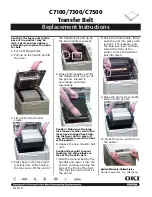
Programming Codes
T480
Programmer’s Guide
Page
88
Rev A
100-14362
Decimal
<27> <31> <113>
IPCL
&%UQ <Name..> <0>
EPOS
[GS] 3
Description
The [ESC] [US] q <Name..> <0> command prints a status report. The file
name is ignored and may be omitted. The NUL must be present. The intention of the
command is to aid in macro development.
The terminating <0> may be replaced with an & or redefined. See [ESC] [EM]T<n> or
&%UT<n> on page 88.
Note:
The report is also printed as part of the configuration report.
Function
Redefine User Store Termination Character
ASCII
[ESC] [EM] T <n>
Hexadecimal
1BH 19H 54H <n>
Decimal
<27> <25> <84> <n>
IPCL
&%UT <n>
EPOS
None
Description
This command allows the terminator used to signal the end of the name
field in User Store commands to be modified. The value of <n> is used (in addition to
the <0>) for the terminator. The value of n may be from 0 to 255.
The default value for the second terminator is &. If this command redefines the
terminator to something other than &, the & will no longer function.
Example
If &%UT% were sent to the printer, the user store command to run macro
"Demo" would be &%URDemo%.
User Macros
The user macro feature works by inserting the macro data buffer into the printer data
stream when the print user-store data command is encountered.
Macros can be any data normally sent to the printer including graphics. (Note: user-store
maintenance and inquire commands may not be included in the macro definitions.) The
printer stores macro data in a RAM-based storage buffer as it is received and
processed. The storage buffer may then be saved to a flash-based user store or inserted
into the print data stream. If a macro is recalled from user store, it is expanded into the
macro buffer and replaces whatever is currently there.
Programming Considerations
The flash (nonvolatile) memory has a limited number of write cycle operations.
Consequently, the number of saves should be limited. The buffer should not be saved on
a transaction by transaction basis, but rather a maximum of once per day.
The buffer is initially about 16K
8
bytes long. All commands
9
and print data are placed in
the buffer and must be included in the size limits. The printer does not indicate when the
buffer is full. The application must make sure that the buffer is not overfilled. The printer
8
The actual buffer is smaller because of the overhead.
9
IPCL commands are converted by the printer into an equivalent [ESC] code and then placed in
the save buffer. The equivalent [ESC] code should be used to calculate the size of the save
buffer data.
















































